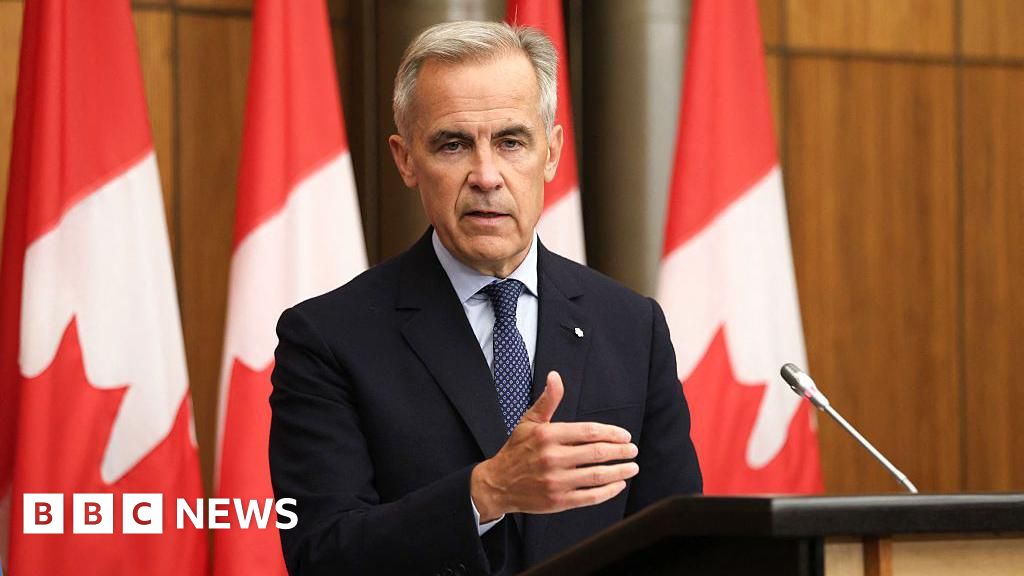Business
Canada to drop some of its retaliatory tariffs on the US

Canada’s Prime Minister Mark Carney said on Friday that his country will drop some of its billions of dollars in retaliatory tariffs on US goods, though it will keep levies on autos, steel and aluminium.
It comes a day after he and President Donald Trump spoke over the phone for the first time since the two countries missed a self-imposed deadline to reach a trade agreement.
Canada had placed a 25% levy on about C$30bn (£16bn; $21.7bn) worth of US goods on an array of products, including orange juice and washing machines.
The tax hike was in retaliation to US tariffs on Canada, which as of August are valued at 35% on all goods not compliant with the countries’ existing free trade deal.
Carney said Canada will now match the US by ending its tariffs on goods compliant with the US-Mexico-Canada free trade agreement (USMCA). He said that would “re-establish free trade for the vast majority” of goods that move between the two countries.
The decision will go into effect on 1 September, Carney said.
In a statement to the BBC’s US news partner CBS, the White House said it welcomes Canada’s move, adding that it is “long overdue” and that the US looks forward to continuing discussions with its northern neighbour about trade and national security.
Trump later told reporters on Friday that he and Carney will speak again over the phone soon.
Canada is one of many countries tariffed by the US as part of Trump’s global trade strategy, but it is one of only two countries – along with China – that have placed retaliatory levies on American goods in response.
Polling shows the majority of Canadians support retaliatory tariffs on the US.
Carney, who was elected in an April general election, campaigned on an aggressive “elbows up” approach to negotiating with Trump, referencing a popular ice hockey term.
Conservative leader Pierre Poilievre criticised Carney for dropping the counter-tariffs, telling reporters that the prime minister’s “elbows have mysteriously gone missing”.
“It is yet another capitulation and climb down by Mark Carney,” Poilievre said.
Asked by reporters about whether Canada was softening its approach, Carney said it has a better tariff deal with the US than many other countries because of the free trade carve-out.
That puts the actual tariff rate on Canadian goods at about 5.6%, much lower than the average of around 16% for other countries, he said.
“As we work to address outstanding trade issues with the US, it’s important we do everything we can to preserve this unique advantage for Canadian workers and businesses,” he said.
Since returning to the White House in January, Trump has imposed tariffs or raising them on goods from around the world, and threatened to go higher as he works to negotiate trade deals he sees as favourable to the US.
The US ambassador to Canada, Pete Hoekstra, said that Canada was jeopardising trade talks by keeping its counter tariffs in place, telling Canadian outlet Global News last week that “it has pulled the rug out from USMCA”.
Washington is also struggling with rhetoric coming from some Canadian politicians against Trump and the US negotiating team, he said.
“They will attack them personally, not on the policy, but them personally,” Hoekstra said. “Again, that is a Canadian decision. All we do is respond to it.”
Carney said the focus will now turn to accelerating negotiations on autos, steel, aluminium and lumber, and other significant sectors ahead of a scheduled review of the USMCA free trade agreement next year.
The US has placed a 50% tariff on all steel and aluminium imports, except for those from the UK, as well as copper imports, along with tariffs on auto imports.
Canada, for its part, has placed 25% tariffs on American steel, aluminium and autos, which will remain in place for now.
Economists have warned that US tariffs on steel and aluminium are “hugely disruptive” to Canada, as it is a major supplier of both metals to the US. Canadian companies have already reported cutbacks and contract cancellations as a result.
Auto manufacturing could also be vulnerable, given how intertwined all three North American countries are in making cars. Typically a car crosses the borders between the US, Canada and Mexico multiple times as it is assembled and prepared to be sold.
The province of Ontario, the centre of auto industry in Canada, has already reported losing 38,000 jobs in the last three months, the bulk of which were in manufacturing.
Business
Peel Hunt cheers ‘positive steps’ in Budget to boost London market and investing

UK investment bank Peel Hunt has given some support to under-pressure Chancellor Rachel Reeves over last week’s Budget as it said efforts to boost the London market and invest in UK companies were “positive steps”.
Peel Hunt welcomed moves announced in the Budget, such as the stamp duty exemption for shares bought in newly listed firms on the London market and changes to Isa investing.
It comes as Ms Reeves has been forced to defend herself against claims she misled voters by talking up the scale of the fiscal challenge in the run-up to last week’s Budget, in which she announced £26 billion worth of tax rises.
Peel Hunt said: “Following a prolonged period of pre-Budget speculation, businesses and investors now have greater clarity from which they can start to plan.
“The key measures were generally well received by markets, particularly the creation of additional headroom against the Chancellor’s fiscal rules.
“Initiatives such as a stamp duty holiday on initial public offerings (IPOs) and adjustments to the Isa framework are intended to support UK capital markets and encourage investment in British companies.
“These developments, alongside the Entrepreneurship in the UK paper published simultaneously, represent positive steps toward enhancing the UK’s attractiveness for growth businesses and long-term investors.”
Ms Reeves last week announced a three-year stamp duty holiday on shares bought in new UK flotations as part of a raft of measures to boost investment in UK shares.
She also unveiled a change to the individual savings account (Isa) limit that lowers the cash element to £12,000 with the remaining £8,000 now redirected into stocks and shares.
But the Chancellor also revealed an unexpected increase in dividend tax, rising by 2% for basic and higher rate taxpayers next year, which experts have warned “undermines the drive to increase investing in Britain”.
Peel Hunt said the London IPO market had begun to revive in the autumn, although listings activity remained low during its first half to the end of September.
Firms that have listed in London over recent months include The Beauty Tech Group, small business lender Shawbrook and tinned tuna firm Princes.
Peel Hunt added that deal activity had “continued at pace” throughout its first half, with 60 transactions announced across the market during that time and 10 active bids for FTSE 350 companies, as at the end of September.
Half-year results for Peel Hunt showed pre-tax profits jumped to £11.5 million in the six months to September 30, up from £1.2 million a year earlier, as revenues lifted 38.3%.
Peel Hunt said its workforce has been cut by nearly 10% since the end of March under an ongoing savings drive, with full-year underlying fixed costs down by around £5 million.
Steven Fine, chief executive of Peel Hunt, said: “The second half has started strongly, with the group continuing to play leading roles across both mergers and acquisitions and equity capital markets mandates.”
Business
Gross GST collections for November stand at over Rs 1.70 lakh crore; up 0.7 per cent – The Times of India

GST collections: The Gross Goods and Services Tax (GST) collections for the month of November came in at over Rs 1.70 lakh crore. This is a rise of 0.7%, according to official data.SBI Research in a report in November had estimated that the gross domestic GST collections may come around Rs 1.49 lakh crore for November 25 (returns of October 25 but filed in Nov’25), a YoY growth of 6.8%.“Coupled with Rs 51,000 crore of IGST and cess on Import, the November GST collections thus could cross Rs 2.0 lakh crore, driven by the peak festive season demand led by lower GST rate and increased compliance while most of states experience positive gains,” SBI Research had said.This story is being updated
Business
Key Financial Deadlines That Have Been Extended For December 2025; Know The Last Date

New Delhi: Several crucial deadlines have been extended in December 2025, including ITR for tax audit cases, ITR filing and PAN and Aadhaar linking. These deadlines will be crucial in ensuring that your financial affairs operate smoothly in the months ahead.
Here is a quick rundown of the important deadlines for December to help you stay compliant and avoid last-minute hassles.
ITR deadline for tax audit cases
The Central Board of Direct Taxes has extended the due date of furnishing of return of income under sub-Section (1) of Section 139 of the Act for the Assessment Year 2025-26 which is October 31, 2025 in the case of assessees referred in clause (a) of Explanation 2 to sub-Section (1) of Section 139 of the Act, to December 10, 2025.
Belated ITR filing deadline
A belated ITR filing happens when an ITR is submitted after the original due date which is permitted by Section 139(4) of the Income Tax Act. Filing a belated return helps you meet your tax obligations, but it involves penalties. You can only file a belated return for FY 2024–25 until December 31, 2025. However, there will be a late fee and interest charged.
PAN and Aadhaar linking deadline
The Income Tax Department has extended the deadline to link their PAN with Aadhaar card to December 31, 2025 for anyone who acquired their PAN using an Aadhaar enrolment ID before October 1, 2024. If you miss this deadline your PAN will become inoperative which will have an impact on your banking transactions, income tax return filing and other financial investments.
-

 Sports1 week ago
Sports1 week agoWATCH: Ronaldo scores spectacular bicycle kick
-

 Entertainment1 week ago
Entertainment1 week agoWelcome to Derry’ episode 5 delivers shocking twist
-

 Politics1 week ago
Politics1 week agoWashington and Kyiv Stress Any Peace Deal Must Fully Respect Ukraine’s Sovereignty
-

 Business1 week ago
Business1 week agoKey economic data and trends that will shape Rachel Reeves’ Budget
-

 Tech6 days ago
Tech6 days agoWake Up—the Best Black Friday Mattress Sales Are Here
-

 Politics1 week ago
Politics1 week ago53,000 Sikhs vote in Ottawa Khalistan Referendum amid Carney-Modi trade talks scrutiny
-

 Fashion1 week ago
Fashion1 week agoCanada’s Lululemon unveils team Canada kit for Milano Cortina 2026
-

 Tech6 days ago
Tech6 days agoThe Alienware Aurora Gaming Desktop Punches Above Its Weight




